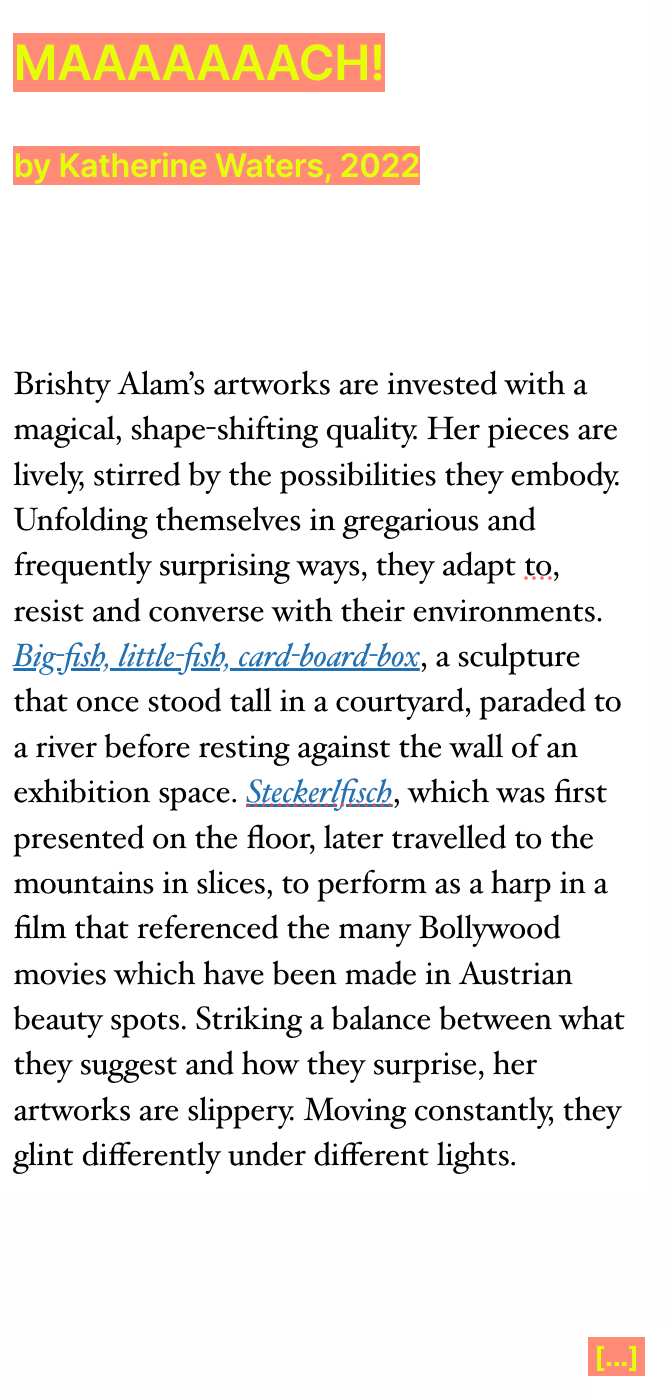MAAAAAAACH!
by Katherine Waters, 2022
Brishty Alam’s artworks are invested with a magical, shape-shifting quality; her pieces are lively, stirred by the possibilities they embody. Unfolding themselves in gregarious and frequently surprising ways, they adapt to, resist and converse with their environments. big-fish, little-fish, card-board-box, a sculpture that once stood tall in a courtyard, paraded to a river before resting against the wall of an exhibition space. Steckerlfisch, which was first presented on the floor, later travelled to the mountains in slices, to perform as a harp in a film that referenced the many Bollywood movies made in Austrian beauty spots. Striking a balance between what they suggest and how they surprise, her artworks are slippery. Moving constantly, they glint differently under different lights.
Yet amid this sense of movement and flux, there’s a rootedness in Brishty’s method, which weighs figuration against abstraction and comes through in the forms and materials she chooses. The droop of fish which tops her sushi sculptures, EBI ICCHOOO! UNI ICCHOO! TORO ICCHOOO!, is made of clay because its hang and heft reflects the flesh it performs. Her extensive use of styrofoam is a product of the material’s ubiquity, cheapness and portability, which indicates the conditions under which she trained and her resistance to the ecological and aesthetic scorn the material attracts. Her Schuppen mimic the texture of fish scales but, separated from a body, have shed their original prompt and suggest fins, tails and wings as well as scraps of fabric and the discarded flakes of masking tape and paper that scatter her studio.
Still, even the tangibility of these materials can create an immersive world while holding that world at a distance. After all, a successful representation is both of, and different to, the original after which it is shaped. While the sushi sculptures represent fish and rice, and their plasticised restaurant display versions, at the same time they are a formal experiment into the interaction of stone and clay. Brishty revels in the transformative tensions offered by the affordances of this paradoxical space.
The body of work which she callsTaking its title from the call of the maach-wallas she’d hear in her early childhood, who go from house to house in Bangladesh, selling fish, the body of work which she calls ‘MAAAAAAACH!’ conjures this sense by which people, objects and materials all participate, all the time, in acts of metamorphosis. These works recall the sounds, smells and sights of a place-time that holds one of the keys to her work, as well as magical shifts in perception – the seller’s nasal call heralding his arrival, the stacked weights temporarily equating to a fish on the scales, the fish themselves which travel along the country’s rivers and so strongly symbolise emigration, movement. Attentiveness proves things to both be, and not be, what they seem.
Her audio piece, Sushi-Go-Round also plays with the space between different forms of representation, striking a delicate balance between pean and parody. The song mimics the soundscape of a sushi-themed video game she and her older brother played as children in their north London living room and combines this with the memory, from many years later, of a visit to Japan when the game’s theme tune would pop, unbidden, into her head. Trespassing the line between insider and outsider, familial and professional, deviance and propriety, the song comes sweetly alive in the humorous space between knowing and unknowing, and stakes a claim for recognition of this state of betweenness.
To embrace so many meanings, so many multitudes, Brishty is constantly creating new forms capable of holding them, because all material is worthy of inclusion, everything is meaningful. Dekho ! Dekho ! Dekho ! shows how closely related the twin tides of artistic generosity and emotional capaciousness are in her work. In the video, Brishty’s khalama cuts a cake, surrounded by children helping her with the knife and a ring of older relatives video-calling the action to relatives in different regions and distant countries. Her Bangladeshi family ring the world, and as presence, distance, relatedness expand outwards, nothing, no-one, is left out. ‘Everyone’s here!’ someone exclaims. And it’s true. In the swell of laughter, the bubble of recognition that rises and fills the space, we’re carried across continents and generations – claiming it, making it matter.
